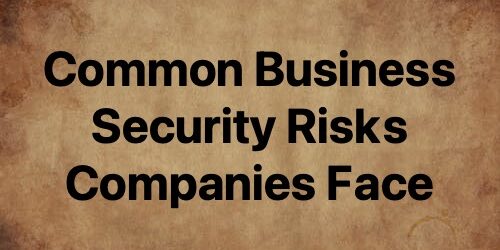Companies in Every Industry Have Business Security Risks That Must Be Assessed. Here Are Some of the Risks and Solutions
Regardless of your business’s type of work, every company must handle sensitive and confidential documents. The information on these documents could range from personal employee information to client information – even your business’s banking information. It is important to protect sensitive and confidential information, and even your merchandise, from becoming a major business security risk.
Listed below are some options that could help protect your business and minimize security risks that many companies fall victim to:
Creating a Process for Filing and Discarding Sensitive Documents
- Limit access to sensitive information
- Shred important documents
- Have strong passwords
At some point, almost every company will have an important or confidential document they need to discard. There are multiple simple solutions to handling this problem.
For one, get a filing cabinet with a lock on it. It is important to keep any sensitive or confidential documents locked away when not in use. Make sure that the only people with the key and access to the filing cabinet are those that are highly trusted members whose job is directly involved with working with those documents.

Once these sensitive documents are no longer needed, do not just casually throw them away. Invest in a good shredder and make sure to always shred those documents. Important documents to shred that have any banking information, personal information, or confidential customer information on them should always be shredded for security purposes.
When it comes to sensitive or confidential information on digital platforms, be sure to have strong passwords. An ideal strong password is over 10 characters total with a mixture of upper and lowercase letters, numbers, and special symbols. It’s important to not have any common knowledge relating to the person in the password such as their birthdate, pet names, or address because it would be easy to find out and guess.
We recommend using random words and elements that do not have a personal meaning to the person creating the password. An example of a strong password is R3d_Tr@cK*_
On top of having a strong password, it is important to change the passwords once a quarter. This will minimize your business’ security risk and protect accounts from encryption.
Faulty Security Systems and Surveillance
- Are your security cameras working (some businesses don’t have proper security systems)?
- For retail, have an operating security system at loading docks
To help prevent employee theft, or just general theft, it is important to have a working security system. If something is stolen or vandalized and the cameras are just for show, there will be no way to prove who was involved or what exactly happened. This can put companies in a sticky situation if they go to the police about an altercation because they will not have the proper evidence.
Theft can be common at loading docks that lack proper security systems, and therefore are a major security risk and cause of retail shrinkage. Loading docks are also an entry point and common location for theft due to the distracted employees and influx of merchandise. With so much happening, it’s easy for someone to steal merchandise or access areas they should not enter.
Security system strategies that can be very useful are cameras, key cards, guards, keeping overhead doors closed and locked when not in use. Conducting regular security audits can also help you find any other security risks specific for your business and industry type.
Employee Background Checks and Vetting
- Conduct background checks on employees
- Restricted access to important access points
When hiring new employees, if they work with sensitive information it is a good idea to perform a background check before either hiring them or allowing them access to important areas such as back offices or filing cabinets. Background checks can also help protect companies from theft and fraud by vetting potential employees for any red flags in their employment background. If there is a concern about an employee’s background, be sure to contact their references or the candidate directly for clarification. However, always trust your intuition when it comes to making a final decision.
Another way to prevent employee theft is to have restricted access to sensitive data. There are few strategies that can be implemented to restrict access and track it. It’s important to create individual accounts and logins for each employee to make it easier to track who has access to what and when they accessed the information.
You can also limit the access of what employees can and cannot do in the software to ensure that a disgruntled employee doesn’t go into the system and destroy important information. Coordinate with your HR department with how the company can minimize risk of destruction or exposure of sensitive information in the event of letting go or laying off employees with access to important information.
Be Vigilant of Cybersecurity Threats – They Are on the Rise
- Make employees aware of potential cybersecurity threats
- Phishing email attempts
- Mobile device security
Small businesses are becoming increasingly common targets for cyber attacks due to them generally having more relaxed security practices and software that is not up to date. One of the most major and common causes of data breaches is innocent mistakes made by employees. It is important to educate employees on the latest security protocols and make sure they are keeping up to date with the latest threats relevant to your business.

One of the ways you can minimize this risk is to make sure employees have strong passwords and the company programs have encryption software built-in. An extra step can be password-protecting certain information to add another level of security.
There are two very common ways that hackers get access to information through employees: through personal cell phones and phishing. First, most people take a more relaxed approach to security on their personal devices such as cell phones and tablets. However, if they are using those devices for accessing work information or systems, it can open up the system to hackers. It is a worthy investment to have anyone who has to access work information on a mobile device to have a company phone or computer instead of using their personal one.
Once those devices are no longer used by that employee, they should be properly equipped to get rid of any sensitive information. For a larger device – such as a computer, certain magnets – can be purchased to wipe the hard drive while on smaller more personal devices you can factory reset the device.
The second approach is phishing, which has become a more common strategy for hackers to access information. This strategy is often carried out through emails. For example, an employee could receive an email from a trusted brand or such. The email content will ask them to reset their password or login to something. Once they change the password, the hacker will now have their information, creating a significant security threat to your business.
A good strategy to catch phishing is if an email feels suspicious, always check the full email address, not just the name as they can be spoofed. Many of these email addresses that are trying to steal information will be @something-suspicious-millions.com. NEVER click on a link that you do not trust or suspect could be a phishing attempt. This also includes the “unsubscribe” link that the email may have at the bottom. Many hackers have used to trick individuals to click a malicious link.
For More Information or to Conduct a Business Risk Assessment, Contact CGA Solutions
The security risks that a company can face are very real, but can also be minimized. For more information regarding a business risk assessment, contact CGA Solutions to discuss strategies to help protect your data and company.







